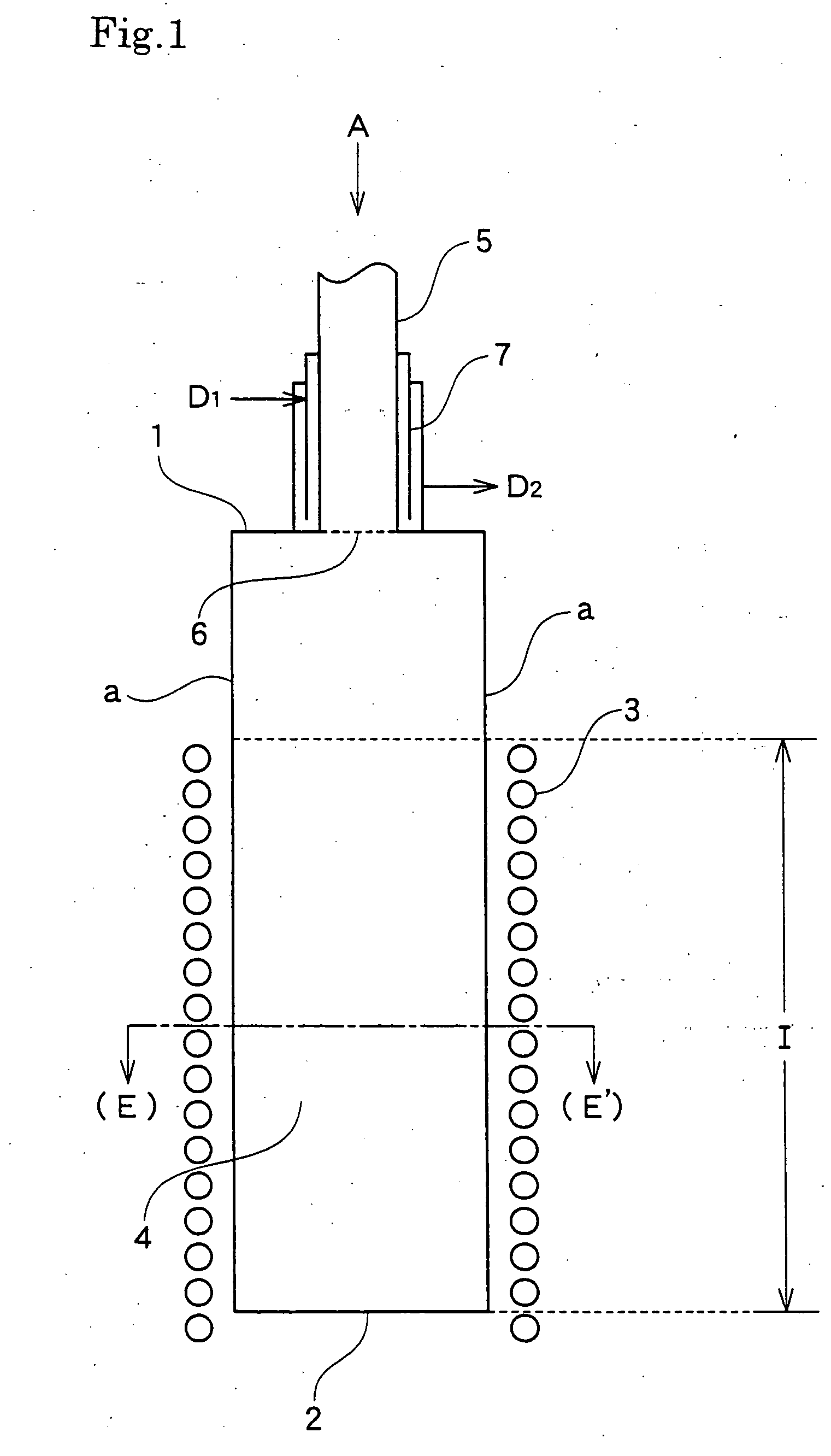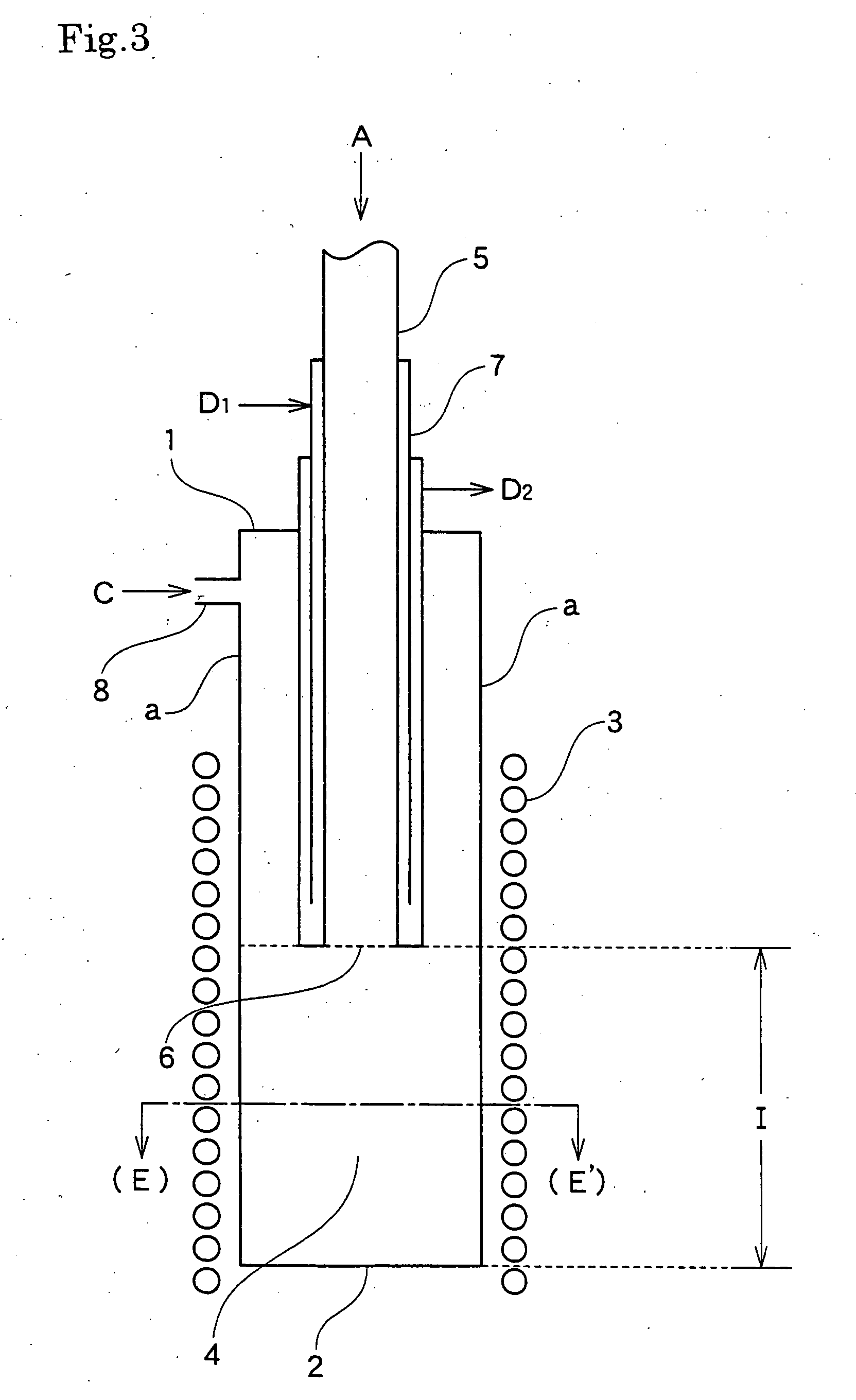Reaction apparatus for producing silicon
a technology of reaction apparatus and silicon, which is applied in the direction of indirect heat exchangers, lighting and heating apparatus, silicon compounds, etc., can solve the problems of reducing raw gas reactivity and the tendency to by-product formation, and achieves the reduction of raw gas reactivity, shortening the distance, and reducing the space
- Summary
- Abstract
- Description
- Claims
- Application Information
AI Technical Summary
Benefits of technology
Problems solved by technology
Method used
Image
Examples
example 1
[0096] Use was made of reaction vessel (1) wherein the vertically extending wall (a) was constituted of graphite, the space (4) surrounded by the wall was of flattened form in cross-sectional view as shown in FIG. 8 and the vessel had the configuration of a cylindrical form of 0.1 m SD, 0.16 m LD, 15 mm thickness and 1.0 m length with opening (2) disposed at the bottom thereof. The raw gas supply pipe (5) was constituted of stainless steel, and the cooling means (7) had a jacket structure permitting liquid passage. The raw gas blowoff port (6) used was of 10 mm×100 mm slit form. The raw gas supply pipe (5) was disposed in the reaction vessel (1) so that the center and major diameter direction of the raw gas blowoff port (6) agreed with those of the flattened form of the space (4) and so that the height of the raw gas blowoff port (6) was such that the length of reaction zone (I) of FIG. 3 was 0.6 m. As the heating means (3) for heating the surface of wall (a) facing the space (4) in...
example 2
[0099] Reaction was performed under the same conditions with the use of the same reactor as in Example 1, except that the space (4) surrounded by the vertically extending wall (a) was changed to flattened form of 0.04 m SD and 0.2 m LD in cross-sectional view, that the raw gas blowoff port (6) of the raw gas supply pipe (5) was changed to 10 mm×170 mm slit form and that accordingly the configuration of high-frequency heating coil as the heating means (3) was changed so as to surround the reaction vessel (1) with a 50 mm thick heat insulating material interposed therebetween. The results are summarized in Table 1. The generation of fine powder silicon was extremely slight.
example 3
[0100] Reaction was performed under the same conditions with the use of the same reactor as in Example 2 except for the following. The space (4) surrounded by the vertically extending wall (a) was changed to flattened form of 0.04 m SD and 1 m LD in cross-sectional view. Accordingly, the configuration of high-frequency heating coil as the heating means (3) was appropriately changed. The raw gas blowoff port (6) was changed to 10 mm×970 mm slit form. With respect to the sealed vessel (10), the interior thereof was of flattened form in cross-sectional view as shown in FIG. 8, and the minor axis and major axis were changed to 0.5 m and 3 m, respectively. The direction of the flattened form was the same as that of the flattened form of the space (4).
[0101] Reaction was performed by effecting flow of hydrogen gas from the seal gas supply pipe (8) and seal gas supply pipe (11) simultaneously at a rate of 25 Nm3 / H and feeding trichlorosilane and hydrogen through the raw gas supply pipe (5...
PUM
| Property | Measurement | Unit |
|---|---|---|
| width | aaaaa | aaaaa |
| temperatures | aaaaa | aaaaa |
| width | aaaaa | aaaaa |
Abstract
Description
Claims
Application Information
 Login to View More
Login to View More - R&D
- Intellectual Property
- Life Sciences
- Materials
- Tech Scout
- Unparalleled Data Quality
- Higher Quality Content
- 60% Fewer Hallucinations
Browse by: Latest US Patents, China's latest patents, Technical Efficacy Thesaurus, Application Domain, Technology Topic, Popular Technical Reports.
© 2025 PatSnap. All rights reserved.Legal|Privacy policy|Modern Slavery Act Transparency Statement|Sitemap|About US| Contact US: help@patsnap.com



